ACCT20074 Final Assignment Term 2, 2017 - Amazon Financial Reporting
VerifiedAdded on 2020/03/23
|9
|3438
|63
Report
AI Summary
This report presents a comprehensive analysis of Amazon's financial reporting, addressing key issues such as the objective of General Purpose Financial Reporting (GPFR) and its relevance to Amazon's stakeholders, including lenders, creditors, and investors. It examines the impact of Jeff Bezos' strategies on shareholder value and the preference for conservative accounting methods. The report delves into shareholder reactions to Amazon's earnings announcements, exploring the application of capital market research (CMR) to understand these reactions and the role of heuristics in investor decision-making. The analysis covers topics such as diversification heuristics and their impact on investment choices. The assignment utilizes academic references to support its arguments and provides insights into the financial performance and investor relations of Amazon.
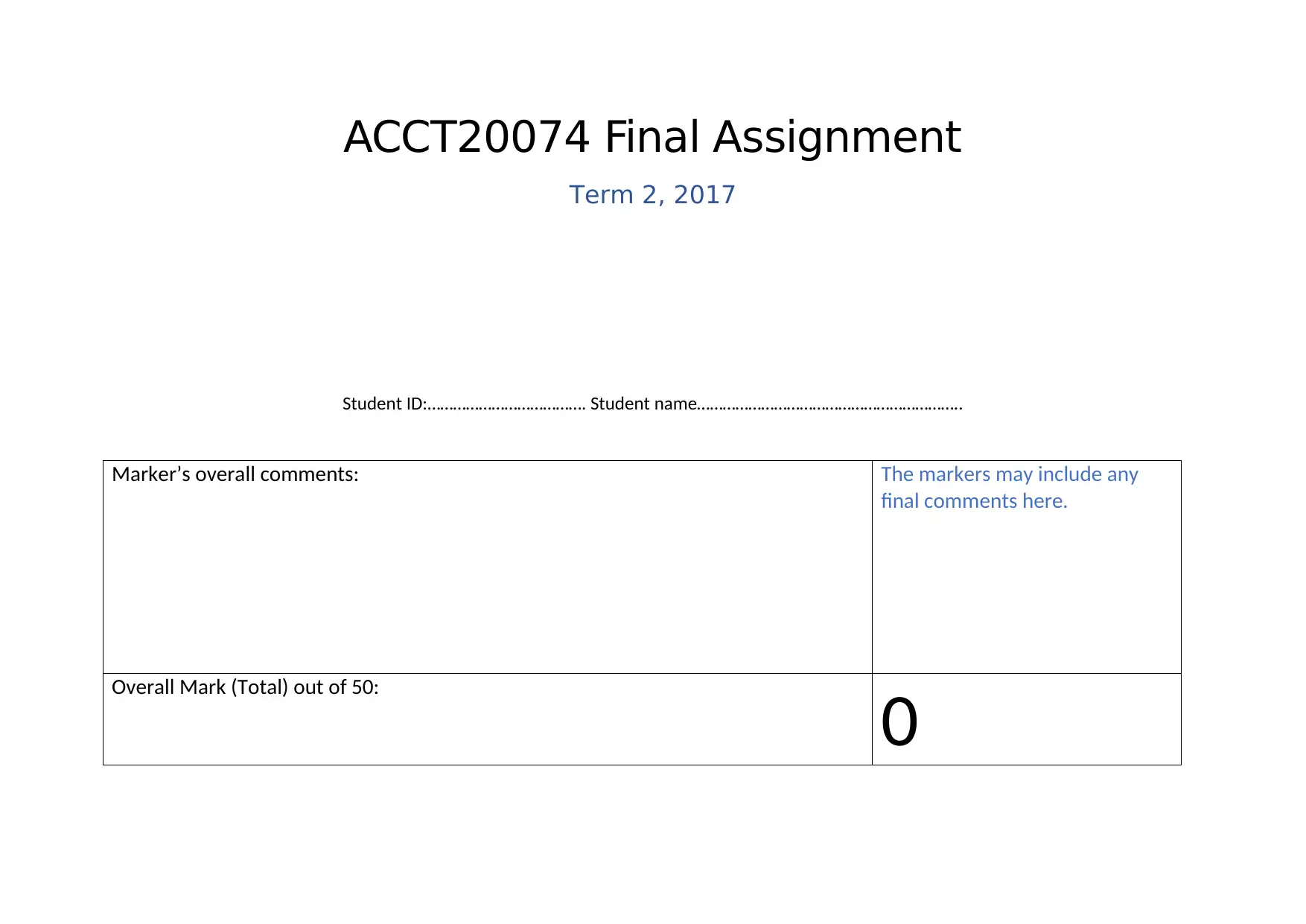
ACCT20074 Final Assignment
Term 2, 2017
Student ID:………………………………. Student name……………………………………………………..
Marker’s overall comments: The markers may include any
final comments here.
Overall Mark (Total) out of 50:
0
Term 2, 2017
Student ID:………………………………. Student name……………………………………………………..
Marker’s overall comments: The markers may include any
final comments here.
Overall Mark (Total) out of 50:
0
Paraphrase This Document
Need a fresh take? Get an instant paraphrase of this document with our AI Paraphraser
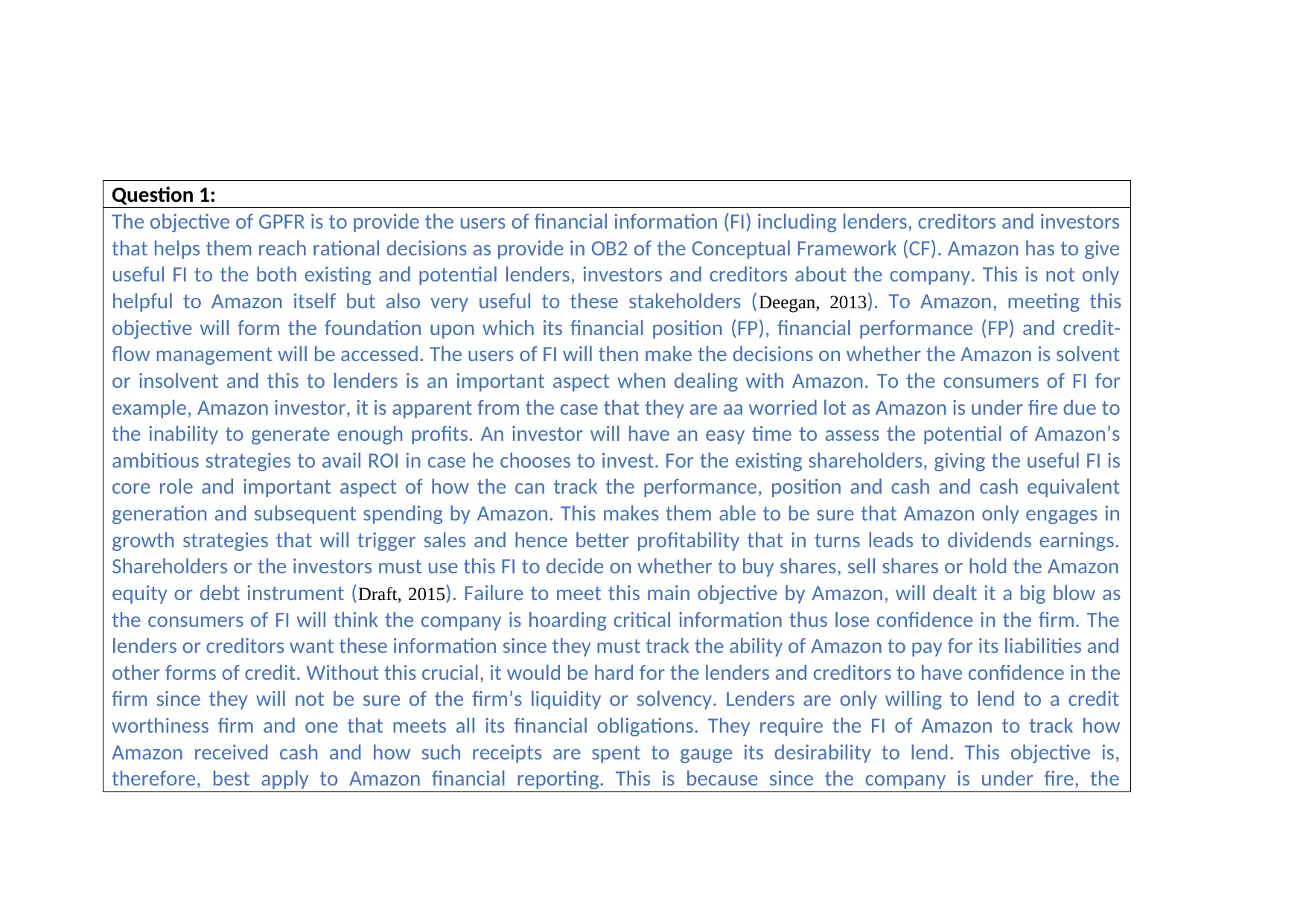
Question 1:
The objective of GPFR is to provide the users of financial information (FI) including lenders, creditors and investors
that helps them reach rational decisions as provide in OB2 of the Conceptual Framework (CF). Amazon has to give
useful FI to the both existing and potential lenders, investors and creditors about the company. This is not only
helpful to Amazon itself but also very useful to these stakeholders (Deegan, 2013). To Amazon, meeting this
objective will form the foundation upon which its financial position (FP), financial performance (FP) and credit-
flow management will be accessed. The users of FI will then make the decisions on whether the Amazon is solvent
or insolvent and this to lenders is an important aspect when dealing with Amazon. To the consumers of FI for
example, Amazon investor, it is apparent from the case that they are aa worried lot as Amazon is under fire due to
the inability to generate enough profits. An investor will have an easy time to assess the potential of Amazon’s
ambitious strategies to avail ROI in case he chooses to invest. For the existing shareholders, giving the useful FI is
core role and important aspect of how the can track the performance, position and cash and cash equivalent
generation and subsequent spending by Amazon. This makes them able to be sure that Amazon only engages in
growth strategies that will trigger sales and hence better profitability that in turns leads to dividends earnings.
Shareholders or the investors must use this FI to decide on whether to buy shares, sell shares or hold the Amazon
equity or debt instrument (Draft, 2015). Failure to meet this main objective by Amazon, will dealt it a big blow as
the consumers of FI will think the company is hoarding critical information thus lose confidence in the firm. The
lenders or creditors want these information since they must track the ability of Amazon to pay for its liabilities and
other forms of credit. Without this crucial, it would be hard for the lenders and creditors to have confidence in the
firm since they will not be sure of the firm’s liquidity or solvency. Lenders are only willing to lend to a credit
worthiness firm and one that meets all its financial obligations. They require the FI of Amazon to track how
Amazon received cash and how such receipts are spent to gauge its desirability to lend. This objective is,
therefore, best apply to Amazon financial reporting. This is because since the company is under fire, the
The objective of GPFR is to provide the users of financial information (FI) including lenders, creditors and investors
that helps them reach rational decisions as provide in OB2 of the Conceptual Framework (CF). Amazon has to give
useful FI to the both existing and potential lenders, investors and creditors about the company. This is not only
helpful to Amazon itself but also very useful to these stakeholders (Deegan, 2013). To Amazon, meeting this
objective will form the foundation upon which its financial position (FP), financial performance (FP) and credit-
flow management will be accessed. The users of FI will then make the decisions on whether the Amazon is solvent
or insolvent and this to lenders is an important aspect when dealing with Amazon. To the consumers of FI for
example, Amazon investor, it is apparent from the case that they are aa worried lot as Amazon is under fire due to
the inability to generate enough profits. An investor will have an easy time to assess the potential of Amazon’s
ambitious strategies to avail ROI in case he chooses to invest. For the existing shareholders, giving the useful FI is
core role and important aspect of how the can track the performance, position and cash and cash equivalent
generation and subsequent spending by Amazon. This makes them able to be sure that Amazon only engages in
growth strategies that will trigger sales and hence better profitability that in turns leads to dividends earnings.
Shareholders or the investors must use this FI to decide on whether to buy shares, sell shares or hold the Amazon
equity or debt instrument (Draft, 2015). Failure to meet this main objective by Amazon, will dealt it a big blow as
the consumers of FI will think the company is hoarding critical information thus lose confidence in the firm. The
lenders or creditors want these information since they must track the ability of Amazon to pay for its liabilities and
other forms of credit. Without this crucial, it would be hard for the lenders and creditors to have confidence in the
firm since they will not be sure of the firm’s liquidity or solvency. Lenders are only willing to lend to a credit
worthiness firm and one that meets all its financial obligations. They require the FI of Amazon to track how
Amazon received cash and how such receipts are spent to gauge its desirability to lend. This objective is,
therefore, best apply to Amazon financial reporting. This is because since the company is under fire, the
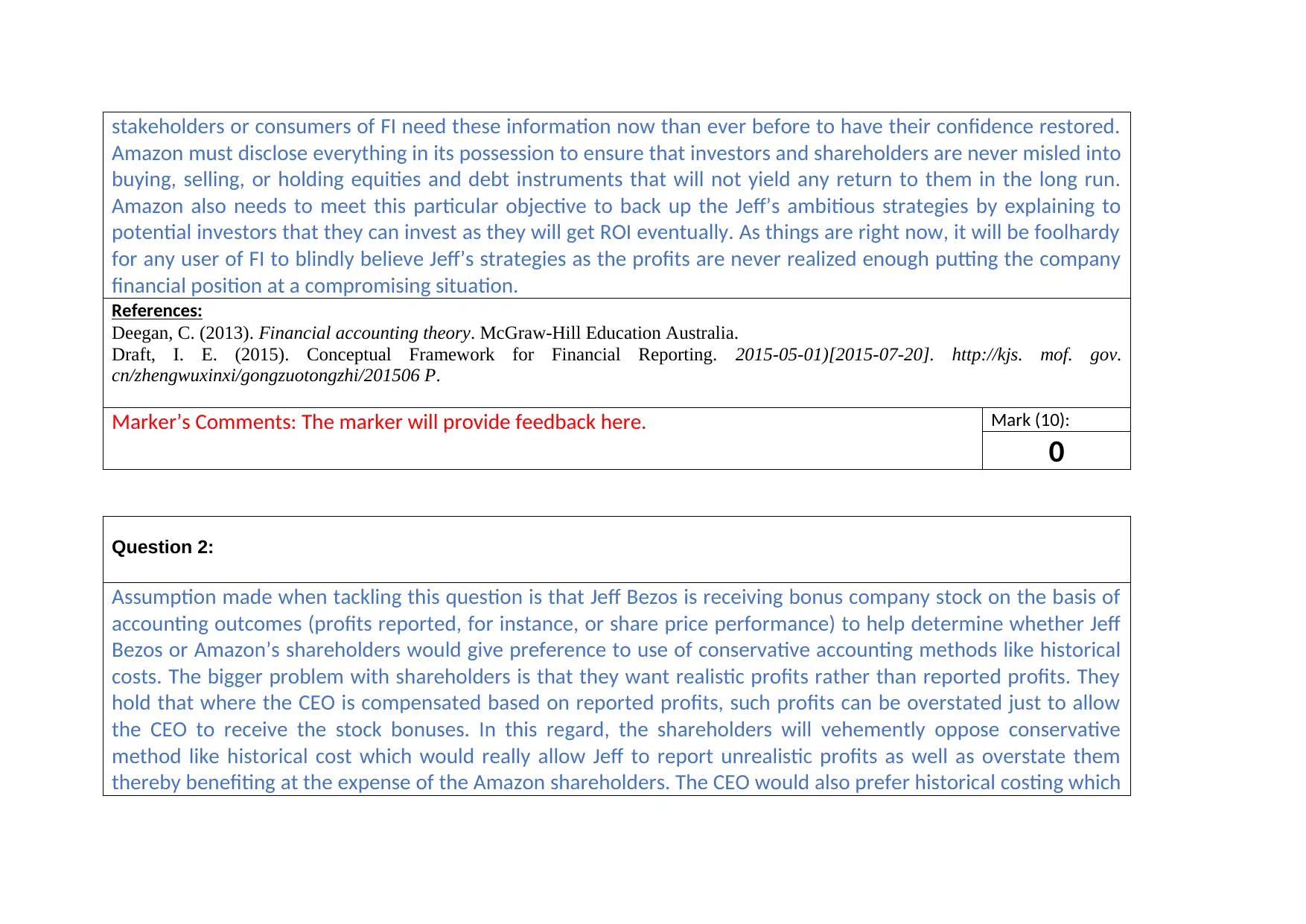
stakeholders or consumers of FI need these information now than ever before to have their confidence restored.
Amazon must disclose everything in its possession to ensure that investors and shareholders are never misled into
buying, selling, or holding equities and debt instruments that will not yield any return to them in the long run.
Amazon also needs to meet this particular objective to back up the Jeff’s ambitious strategies by explaining to
potential investors that they can invest as they will get ROI eventually. As things are right now, it will be foolhardy
for any user of FI to blindly believe Jeff’s strategies as the profits are never realized enough putting the company
financial position at a compromising situation.
References:
Deegan, C. (2013). Financial accounting theory. McGraw-Hill Education Australia.
Draft, I. E. (2015). Conceptual Framework for Financial Reporting. 2015-05-01)[2015-07-20]. http://kjs. mof. gov.
cn/zhengwuxinxi/gongzuotongzhi/201506 P.
Marker’s Comments: The marker will provide feedback here. Mark (10):
0
Question 2:
Assumption made when tackling this question is that Jeff Bezos is receiving bonus company stock on the basis of
accounting outcomes (profits reported, for instance, or share price performance) to help determine whether Jeff
Bezos or Amazon’s shareholders would give preference to use of conservative accounting methods like historical
costs. The bigger problem with shareholders is that they want realistic profits rather than reported profits. They
hold that where the CEO is compensated based on reported profits, such profits can be overstated just to allow
the CEO to receive the stock bonuses. In this regard, the shareholders will vehemently oppose conservative
method like historical cost which would really allow Jeff to report unrealistic profits as well as overstate them
thereby benefiting at the expense of the Amazon shareholders. The CEO would also prefer historical costing which
Amazon must disclose everything in its possession to ensure that investors and shareholders are never misled into
buying, selling, or holding equities and debt instruments that will not yield any return to them in the long run.
Amazon also needs to meet this particular objective to back up the Jeff’s ambitious strategies by explaining to
potential investors that they can invest as they will get ROI eventually. As things are right now, it will be foolhardy
for any user of FI to blindly believe Jeff’s strategies as the profits are never realized enough putting the company
financial position at a compromising situation.
References:
Deegan, C. (2013). Financial accounting theory. McGraw-Hill Education Australia.
Draft, I. E. (2015). Conceptual Framework for Financial Reporting. 2015-05-01)[2015-07-20]. http://kjs. mof. gov.
cn/zhengwuxinxi/gongzuotongzhi/201506 P.
Marker’s Comments: The marker will provide feedback here. Mark (10):
0
Question 2:
Assumption made when tackling this question is that Jeff Bezos is receiving bonus company stock on the basis of
accounting outcomes (profits reported, for instance, or share price performance) to help determine whether Jeff
Bezos or Amazon’s shareholders would give preference to use of conservative accounting methods like historical
costs. The bigger problem with shareholders is that they want realistic profits rather than reported profits. They
hold that where the CEO is compensated based on reported profits, such profits can be overstated just to allow
the CEO to receive the stock bonuses. In this regard, the shareholders will vehemently oppose conservative
method like historical cost which would really allow Jeff to report unrealistic profits as well as overstate them
thereby benefiting at the expense of the Amazon shareholders. The CEO would also prefer historical costing which
⊘ This is a preview!⊘
Do you want full access?
Subscribe today to unlock all pages.

Trusted by 1+ million students worldwide
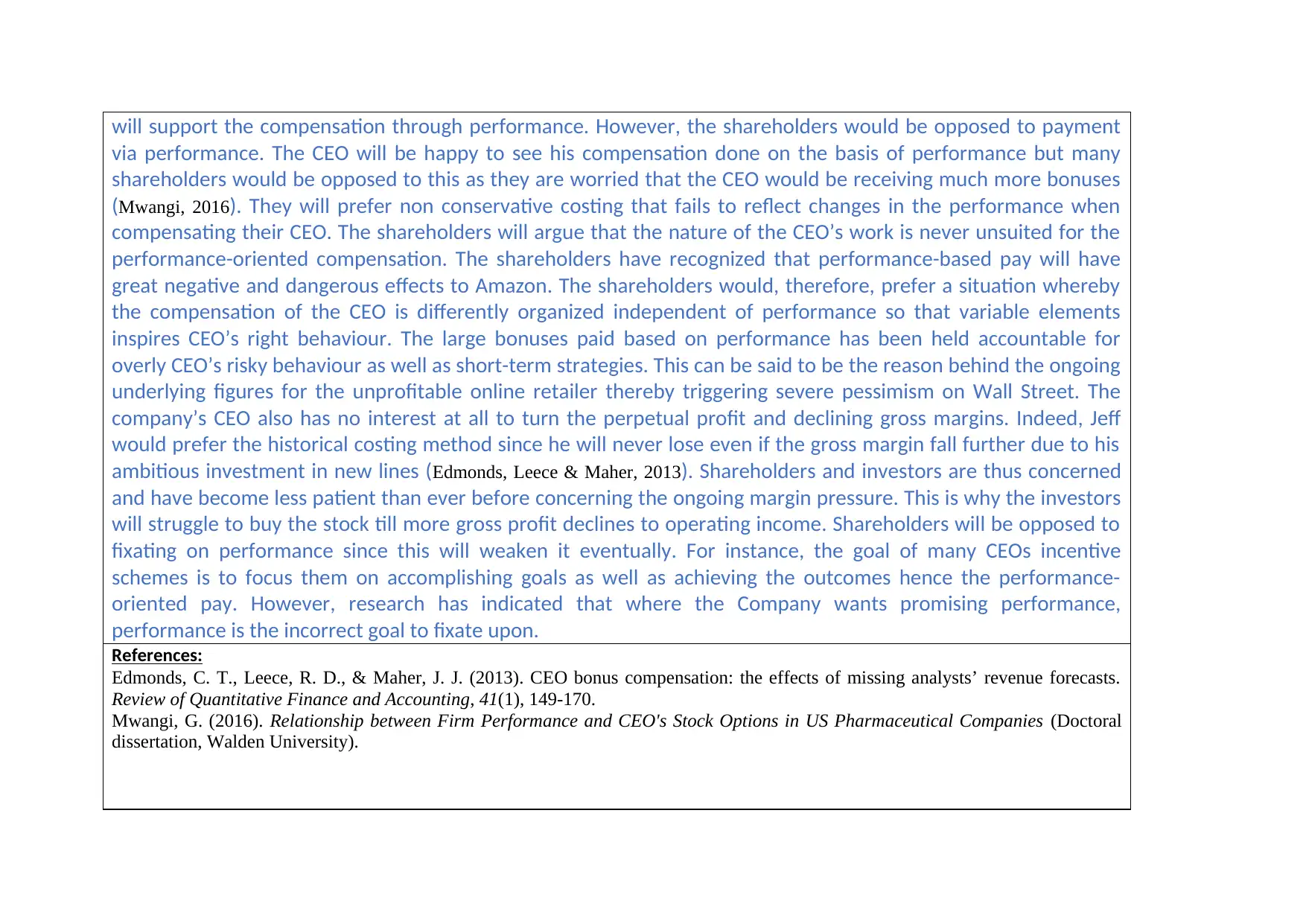
will support the compensation through performance. However, the shareholders would be opposed to payment
via performance. The CEO will be happy to see his compensation done on the basis of performance but many
shareholders would be opposed to this as they are worried that the CEO would be receiving much more bonuses
(Mwangi, 2016). They will prefer non conservative costing that fails to reflect changes in the performance when
compensating their CEO. The shareholders will argue that the nature of the CEO’s work is never unsuited for the
performance-oriented compensation. The shareholders have recognized that performance-based pay will have
great negative and dangerous effects to Amazon. The shareholders would, therefore, prefer a situation whereby
the compensation of the CEO is differently organized independent of performance so that variable elements
inspires CEO’s right behaviour. The large bonuses paid based on performance has been held accountable for
overly CEO’s risky behaviour as well as short-term strategies. This can be said to be the reason behind the ongoing
underlying figures for the unprofitable online retailer thereby triggering severe pessimism on Wall Street. The
company’s CEO also has no interest at all to turn the perpetual profit and declining gross margins. Indeed, Jeff
would prefer the historical costing method since he will never lose even if the gross margin fall further due to his
ambitious investment in new lines (Edmonds, Leece & Maher, 2013). Shareholders and investors are thus concerned
and have become less patient than ever before concerning the ongoing margin pressure. This is why the investors
will struggle to buy the stock till more gross profit declines to operating income. Shareholders will be opposed to
fixating on performance since this will weaken it eventually. For instance, the goal of many CEOs incentive
schemes is to focus them on accomplishing goals as well as achieving the outcomes hence the performance-
oriented pay. However, research has indicated that where the Company wants promising performance,
performance is the incorrect goal to fixate upon.
References:
Edmonds, C. T., Leece, R. D., & Maher, J. J. (2013). CEO bonus compensation: the effects of missing analysts’ revenue forecasts.
Review of Quantitative Finance and Accounting, 41(1), 149-170.
Mwangi, G. (2016). Relationship between Firm Performance and CEO's Stock Options in US Pharmaceutical Companies (Doctoral
dissertation, Walden University).
via performance. The CEO will be happy to see his compensation done on the basis of performance but many
shareholders would be opposed to this as they are worried that the CEO would be receiving much more bonuses
(Mwangi, 2016). They will prefer non conservative costing that fails to reflect changes in the performance when
compensating their CEO. The shareholders will argue that the nature of the CEO’s work is never unsuited for the
performance-oriented compensation. The shareholders have recognized that performance-based pay will have
great negative and dangerous effects to Amazon. The shareholders would, therefore, prefer a situation whereby
the compensation of the CEO is differently organized independent of performance so that variable elements
inspires CEO’s right behaviour. The large bonuses paid based on performance has been held accountable for
overly CEO’s risky behaviour as well as short-term strategies. This can be said to be the reason behind the ongoing
underlying figures for the unprofitable online retailer thereby triggering severe pessimism on Wall Street. The
company’s CEO also has no interest at all to turn the perpetual profit and declining gross margins. Indeed, Jeff
would prefer the historical costing method since he will never lose even if the gross margin fall further due to his
ambitious investment in new lines (Edmonds, Leece & Maher, 2013). Shareholders and investors are thus concerned
and have become less patient than ever before concerning the ongoing margin pressure. This is why the investors
will struggle to buy the stock till more gross profit declines to operating income. Shareholders will be opposed to
fixating on performance since this will weaken it eventually. For instance, the goal of many CEOs incentive
schemes is to focus them on accomplishing goals as well as achieving the outcomes hence the performance-
oriented pay. However, research has indicated that where the Company wants promising performance,
performance is the incorrect goal to fixate upon.
References:
Edmonds, C. T., Leece, R. D., & Maher, J. J. (2013). CEO bonus compensation: the effects of missing analysts’ revenue forecasts.
Review of Quantitative Finance and Accounting, 41(1), 149-170.
Mwangi, G. (2016). Relationship between Firm Performance and CEO's Stock Options in US Pharmaceutical Companies (Doctoral
dissertation, Walden University).
Paraphrase This Document
Need a fresh take? Get an instant paraphrase of this document with our AI Paraphraser
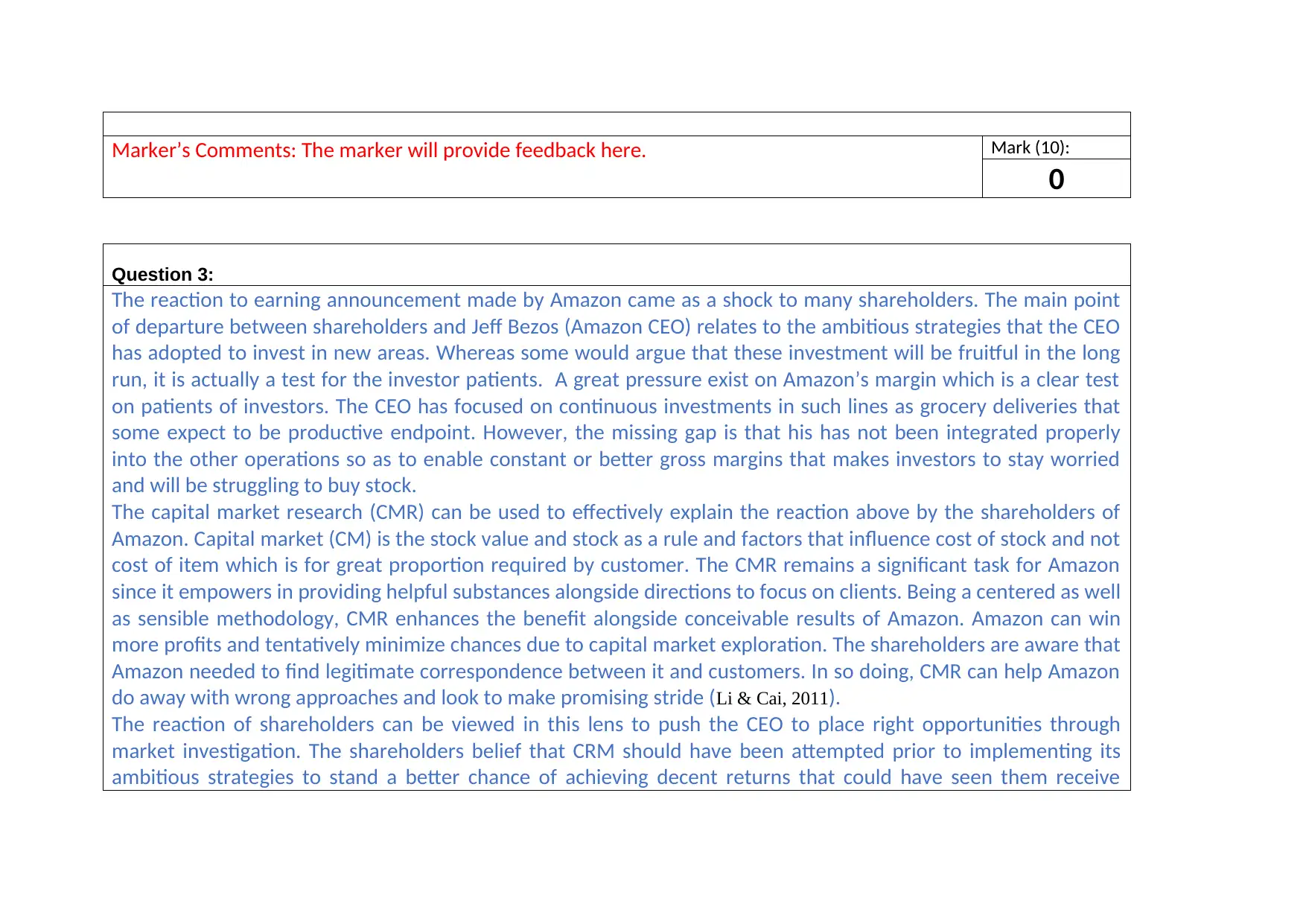
Marker’s Comments: The marker will provide feedback here. Mark (10):
0
Question 3:
The reaction to earning announcement made by Amazon came as a shock to many shareholders. The main point
of departure between shareholders and Jeff Bezos (Amazon CEO) relates to the ambitious strategies that the CEO
has adopted to invest in new areas. Whereas some would argue that these investment will be fruitful in the long
run, it is actually a test for the investor patients. A great pressure exist on Amazon’s margin which is a clear test
on patients of investors. The CEO has focused on continuous investments in such lines as grocery deliveries that
some expect to be productive endpoint. However, the missing gap is that his has not been integrated properly
into the other operations so as to enable constant or better gross margins that makes investors to stay worried
and will be struggling to buy stock.
The capital market research (CMR) can be used to effectively explain the reaction above by the shareholders of
Amazon. Capital market (CM) is the stock value and stock as a rule and factors that influence cost of stock and not
cost of item which is for great proportion required by customer. The CMR remains a significant task for Amazon
since it empowers in providing helpful substances alongside directions to focus on clients. Being a centered as well
as sensible methodology, CMR enhances the benefit alongside conceivable results of Amazon. Amazon can win
more profits and tentatively minimize chances due to capital market exploration. The shareholders are aware that
Amazon needed to find legitimate correspondence between it and customers. In so doing, CMR can help Amazon
do away with wrong approaches and look to make promising stride (Li & Cai, 2011).
The reaction of shareholders can be viewed in this lens to push the CEO to place right opportunities through
market investigation. The shareholders belief that CRM should have been attempted prior to implementing its
ambitious strategies to stand a better chance of achieving decent returns that could have seen them receive
0
Question 3:
The reaction to earning announcement made by Amazon came as a shock to many shareholders. The main point
of departure between shareholders and Jeff Bezos (Amazon CEO) relates to the ambitious strategies that the CEO
has adopted to invest in new areas. Whereas some would argue that these investment will be fruitful in the long
run, it is actually a test for the investor patients. A great pressure exist on Amazon’s margin which is a clear test
on patients of investors. The CEO has focused on continuous investments in such lines as grocery deliveries that
some expect to be productive endpoint. However, the missing gap is that his has not been integrated properly
into the other operations so as to enable constant or better gross margins that makes investors to stay worried
and will be struggling to buy stock.
The capital market research (CMR) can be used to effectively explain the reaction above by the shareholders of
Amazon. Capital market (CM) is the stock value and stock as a rule and factors that influence cost of stock and not
cost of item which is for great proportion required by customer. The CMR remains a significant task for Amazon
since it empowers in providing helpful substances alongside directions to focus on clients. Being a centered as well
as sensible methodology, CMR enhances the benefit alongside conceivable results of Amazon. Amazon can win
more profits and tentatively minimize chances due to capital market exploration. The shareholders are aware that
Amazon needed to find legitimate correspondence between it and customers. In so doing, CMR can help Amazon
do away with wrong approaches and look to make promising stride (Li & Cai, 2011).
The reaction of shareholders can be viewed in this lens to push the CEO to place right opportunities through
market investigation. The shareholders belief that CRM should have been attempted prior to implementing its
ambitious strategies to stand a better chance of achieving decent returns that could have seen them receive
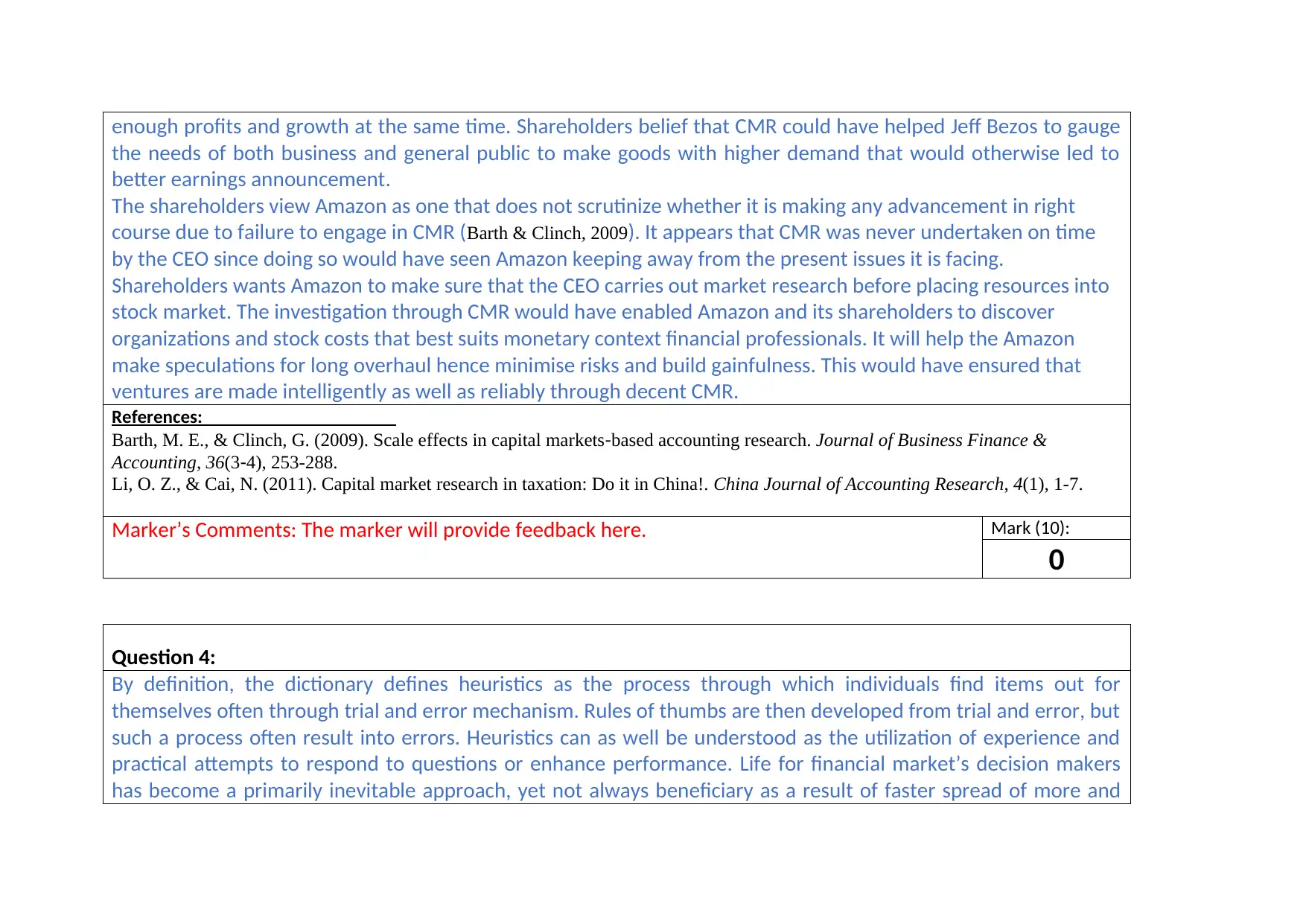
enough profits and growth at the same time. Shareholders belief that CMR could have helped Jeff Bezos to gauge
the needs of both business and general public to make goods with higher demand that would otherwise led to
better earnings announcement.
The shareholders view Amazon as one that does not scrutinize whether it is making any advancement in right
course due to failure to engage in CMR (Barth & Clinch, 2009). It appears that CMR was never undertaken on time
by the CEO since doing so would have seen Amazon keeping away from the present issues it is facing.
Shareholders wants Amazon to make sure that the CEO carries out market research before placing resources into
stock market. The investigation through CMR would have enabled Amazon and its shareholders to discover
organizations and stock costs that best suits monetary context financial professionals. It will help the Amazon
make speculations for long overhaul hence minimise risks and build gainfulness. This would have ensured that
ventures are made intelligently as well as reliably through decent CMR.
References:
Barth, M. E., & Clinch, G. (2009). Scale effects in capital markets‐based accounting research. Journal of Business Finance &
Accounting, 36(3‐4), 253-288.
Li, O. Z., & Cai, N. (2011). Capital market research in taxation: Do it in China!. China Journal of Accounting Research, 4(1), 1-7.
Marker’s Comments: The marker will provide feedback here. Mark (10):
0
Question 4:
By definition, the dictionary defines heuristics as the process through which individuals find items out for
themselves often through trial and error mechanism. Rules of thumbs are then developed from trial and error, but
such a process often result into errors. Heuristics can as well be understood as the utilization of experience and
practical attempts to respond to questions or enhance performance. Life for financial market’s decision makers
has become a primarily inevitable approach, yet not always beneficiary as a result of faster spread of more and
the needs of both business and general public to make goods with higher demand that would otherwise led to
better earnings announcement.
The shareholders view Amazon as one that does not scrutinize whether it is making any advancement in right
course due to failure to engage in CMR (Barth & Clinch, 2009). It appears that CMR was never undertaken on time
by the CEO since doing so would have seen Amazon keeping away from the present issues it is facing.
Shareholders wants Amazon to make sure that the CEO carries out market research before placing resources into
stock market. The investigation through CMR would have enabled Amazon and its shareholders to discover
organizations and stock costs that best suits monetary context financial professionals. It will help the Amazon
make speculations for long overhaul hence minimise risks and build gainfulness. This would have ensured that
ventures are made intelligently as well as reliably through decent CMR.
References:
Barth, M. E., & Clinch, G. (2009). Scale effects in capital markets‐based accounting research. Journal of Business Finance &
Accounting, 36(3‐4), 253-288.
Li, O. Z., & Cai, N. (2011). Capital market research in taxation: Do it in China!. China Journal of Accounting Research, 4(1), 1-7.
Marker’s Comments: The marker will provide feedback here. Mark (10):
0
Question 4:
By definition, the dictionary defines heuristics as the process through which individuals find items out for
themselves often through trial and error mechanism. Rules of thumbs are then developed from trial and error, but
such a process often result into errors. Heuristics can as well be understood as the utilization of experience and
practical attempts to respond to questions or enhance performance. Life for financial market’s decision makers
has become a primarily inevitable approach, yet not always beneficiary as a result of faster spread of more and
⊘ This is a preview!⊘
Do you want full access?
Subscribe today to unlock all pages.

Trusted by 1+ million students worldwide
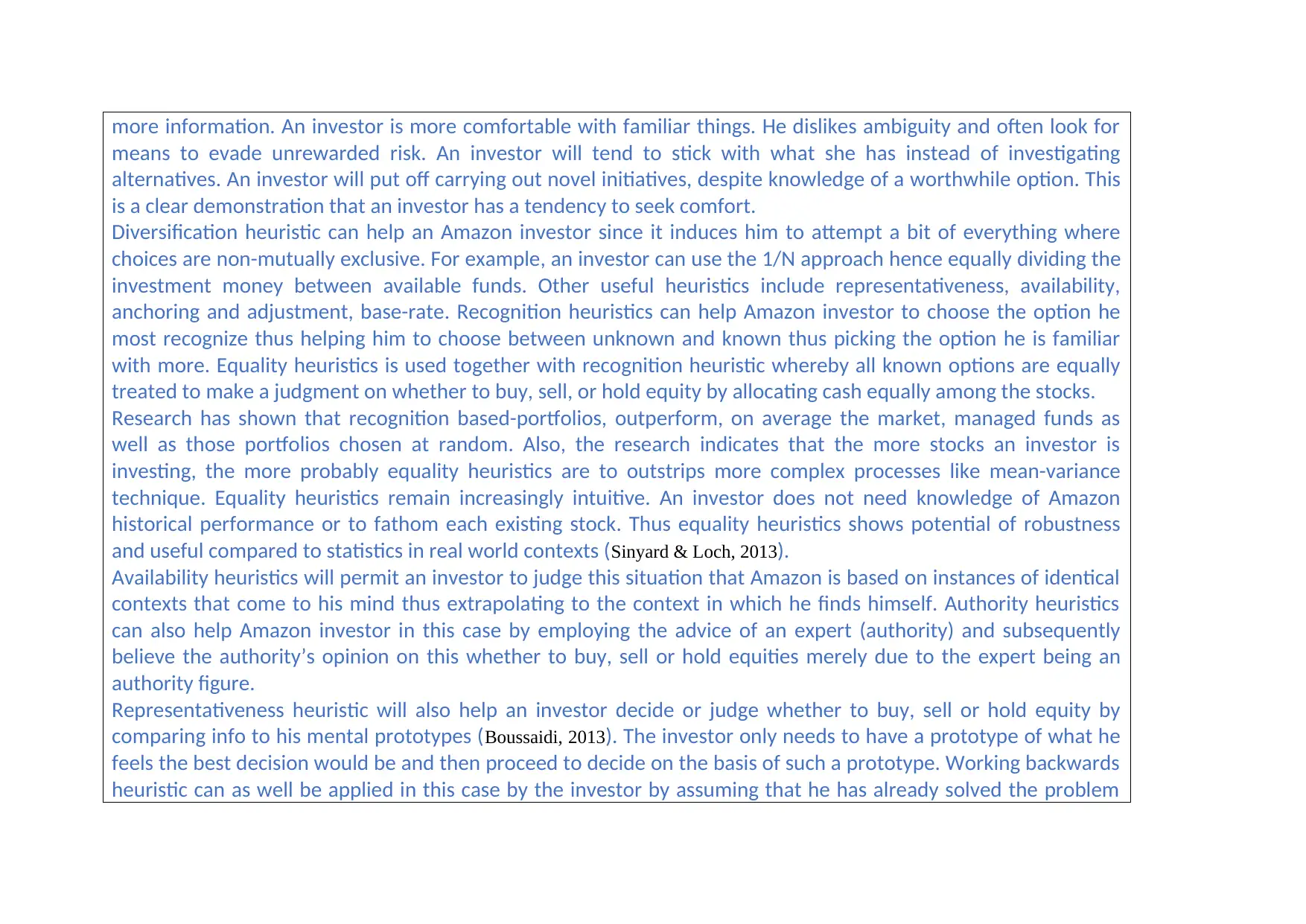
more information. An investor is more comfortable with familiar things. He dislikes ambiguity and often look for
means to evade unrewarded risk. An investor will tend to stick with what she has instead of investigating
alternatives. An investor will put off carrying out novel initiatives, despite knowledge of a worthwhile option. This
is a clear demonstration that an investor has a tendency to seek comfort.
Diversification heuristic can help an Amazon investor since it induces him to attempt a bit of everything where
choices are non-mutually exclusive. For example, an investor can use the 1/N approach hence equally dividing the
investment money between available funds. Other useful heuristics include representativeness, availability,
anchoring and adjustment, base-rate. Recognition heuristics can help Amazon investor to choose the option he
most recognize thus helping him to choose between unknown and known thus picking the option he is familiar
with more. Equality heuristics is used together with recognition heuristic whereby all known options are equally
treated to make a judgment on whether to buy, sell, or hold equity by allocating cash equally among the stocks.
Research has shown that recognition based-portfolios, outperform, on average the market, managed funds as
well as those portfolios chosen at random. Also, the research indicates that the more stocks an investor is
investing, the more probably equality heuristics are to outstrips more complex processes like mean-variance
technique. Equality heuristics remain increasingly intuitive. An investor does not need knowledge of Amazon
historical performance or to fathom each existing stock. Thus equality heuristics shows potential of robustness
and useful compared to statistics in real world contexts (Sinyard & Loch, 2013).
Availability heuristics will permit an investor to judge this situation that Amazon is based on instances of identical
contexts that come to his mind thus extrapolating to the context in which he finds himself. Authority heuristics
can also help Amazon investor in this case by employing the advice of an expert (authority) and subsequently
believe the authority’s opinion on this whether to buy, sell or hold equities merely due to the expert being an
authority figure.
Representativeness heuristic will also help an investor decide or judge whether to buy, sell or hold equity by
comparing info to his mental prototypes (Boussaidi, 2013). The investor only needs to have a prototype of what he
feels the best decision would be and then proceed to decide on the basis of such a prototype. Working backwards
heuristic can as well be applied in this case by the investor by assuming that he has already solved the problem
means to evade unrewarded risk. An investor will tend to stick with what she has instead of investigating
alternatives. An investor will put off carrying out novel initiatives, despite knowledge of a worthwhile option. This
is a clear demonstration that an investor has a tendency to seek comfort.
Diversification heuristic can help an Amazon investor since it induces him to attempt a bit of everything where
choices are non-mutually exclusive. For example, an investor can use the 1/N approach hence equally dividing the
investment money between available funds. Other useful heuristics include representativeness, availability,
anchoring and adjustment, base-rate. Recognition heuristics can help Amazon investor to choose the option he
most recognize thus helping him to choose between unknown and known thus picking the option he is familiar
with more. Equality heuristics is used together with recognition heuristic whereby all known options are equally
treated to make a judgment on whether to buy, sell, or hold equity by allocating cash equally among the stocks.
Research has shown that recognition based-portfolios, outperform, on average the market, managed funds as
well as those portfolios chosen at random. Also, the research indicates that the more stocks an investor is
investing, the more probably equality heuristics are to outstrips more complex processes like mean-variance
technique. Equality heuristics remain increasingly intuitive. An investor does not need knowledge of Amazon
historical performance or to fathom each existing stock. Thus equality heuristics shows potential of robustness
and useful compared to statistics in real world contexts (Sinyard & Loch, 2013).
Availability heuristics will permit an investor to judge this situation that Amazon is based on instances of identical
contexts that come to his mind thus extrapolating to the context in which he finds himself. Authority heuristics
can also help Amazon investor in this case by employing the advice of an expert (authority) and subsequently
believe the authority’s opinion on this whether to buy, sell or hold equities merely due to the expert being an
authority figure.
Representativeness heuristic will also help an investor decide or judge whether to buy, sell or hold equity by
comparing info to his mental prototypes (Boussaidi, 2013). The investor only needs to have a prototype of what he
feels the best decision would be and then proceed to decide on the basis of such a prototype. Working backwards
heuristic can as well be applied in this case by the investor by assuming that he has already solved the problem
Paraphrase This Document
Need a fresh take? Get an instant paraphrase of this document with our AI Paraphraser
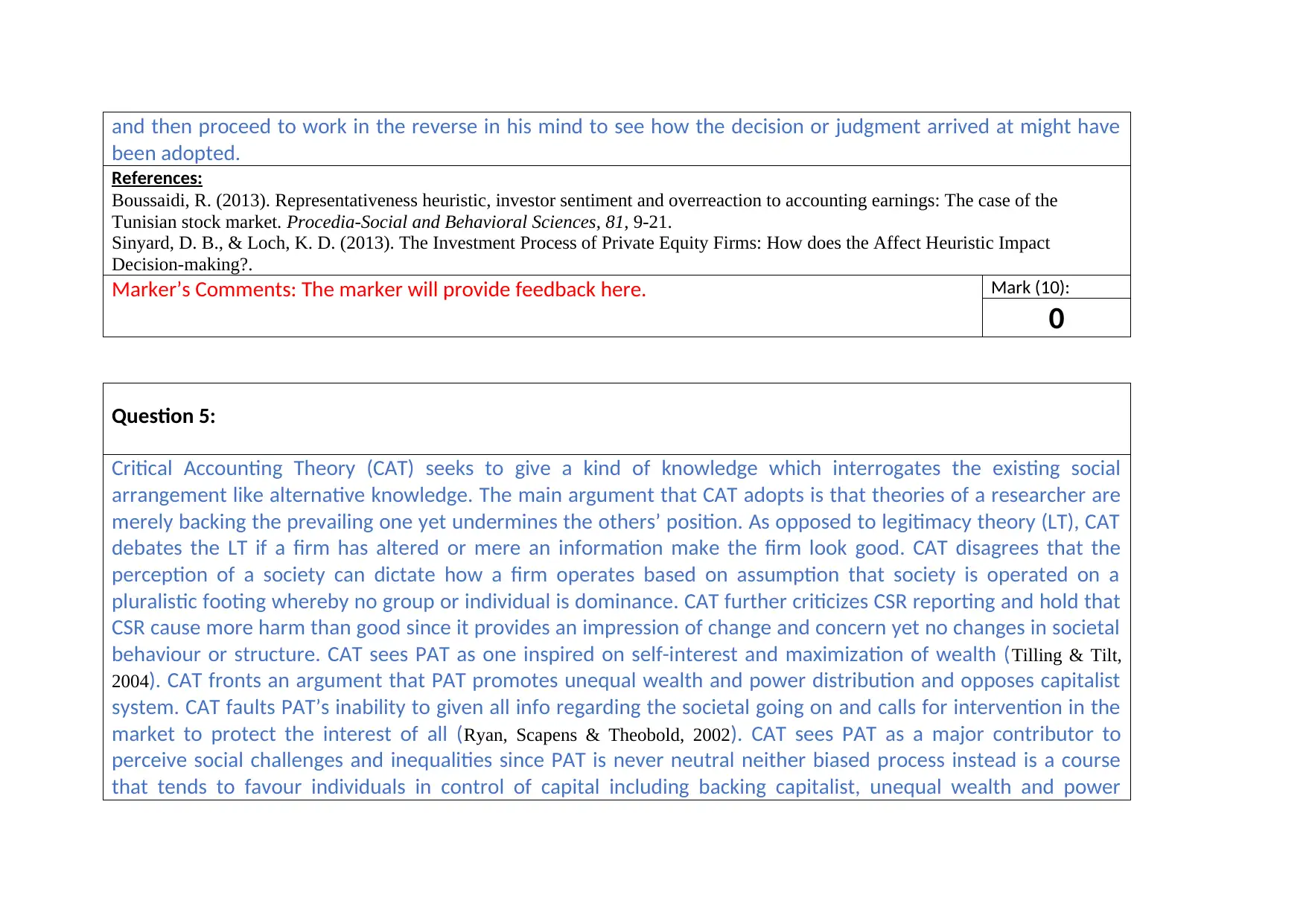
and then proceed to work in the reverse in his mind to see how the decision or judgment arrived at might have
been adopted.
References:
Boussaidi, R. (2013). Representativeness heuristic, investor sentiment and overreaction to accounting earnings: The case of the
Tunisian stock market. Procedia-Social and Behavioral Sciences, 81, 9-21.
Sinyard, D. B., & Loch, K. D. (2013). The Investment Process of Private Equity Firms: How does the Affect Heuristic Impact
Decision-making?.
Marker’s Comments: The marker will provide feedback here. Mark (10):
0
Question 5:
Critical Accounting Theory (CAT) seeks to give a kind of knowledge which interrogates the existing social
arrangement like alternative knowledge. The main argument that CAT adopts is that theories of a researcher are
merely backing the prevailing one yet undermines the others’ position. As opposed to legitimacy theory (LT), CAT
debates the LT if a firm has altered or mere an information make the firm look good. CAT disagrees that the
perception of a society can dictate how a firm operates based on assumption that society is operated on a
pluralistic footing whereby no group or individual is dominance. CAT further criticizes CSR reporting and hold that
CSR cause more harm than good since it provides an impression of change and concern yet no changes in societal
behaviour or structure. CAT sees PAT as one inspired on self-interest and maximization of wealth (Tilling & Tilt,
2004). CAT fronts an argument that PAT promotes unequal wealth and power distribution and opposes capitalist
system. CAT faults PAT’s inability to given all info regarding the societal going on and calls for intervention in the
market to protect the interest of all (Ryan, Scapens & Theobold, 2002). CAT sees PAT as a major contributor to
perceive social challenges and inequalities since PAT is never neutral neither biased process instead is a course
that tends to favour individuals in control of capital including backing capitalist, unequal wealth and power
been adopted.
References:
Boussaidi, R. (2013). Representativeness heuristic, investor sentiment and overreaction to accounting earnings: The case of the
Tunisian stock market. Procedia-Social and Behavioral Sciences, 81, 9-21.
Sinyard, D. B., & Loch, K. D. (2013). The Investment Process of Private Equity Firms: How does the Affect Heuristic Impact
Decision-making?.
Marker’s Comments: The marker will provide feedback here. Mark (10):
0
Question 5:
Critical Accounting Theory (CAT) seeks to give a kind of knowledge which interrogates the existing social
arrangement like alternative knowledge. The main argument that CAT adopts is that theories of a researcher are
merely backing the prevailing one yet undermines the others’ position. As opposed to legitimacy theory (LT), CAT
debates the LT if a firm has altered or mere an information make the firm look good. CAT disagrees that the
perception of a society can dictate how a firm operates based on assumption that society is operated on a
pluralistic footing whereby no group or individual is dominance. CAT further criticizes CSR reporting and hold that
CSR cause more harm than good since it provides an impression of change and concern yet no changes in societal
behaviour or structure. CAT sees PAT as one inspired on self-interest and maximization of wealth (Tilling & Tilt,
2004). CAT fronts an argument that PAT promotes unequal wealth and power distribution and opposes capitalist
system. CAT faults PAT’s inability to given all info regarding the societal going on and calls for intervention in the
market to protect the interest of all (Ryan, Scapens & Theobold, 2002). CAT sees PAT as a major contributor to
perceive social challenges and inequalities since PAT is never neutral neither biased process instead is a course
that tends to favour individuals in control of capital including backing capitalist, unequal wealth and power
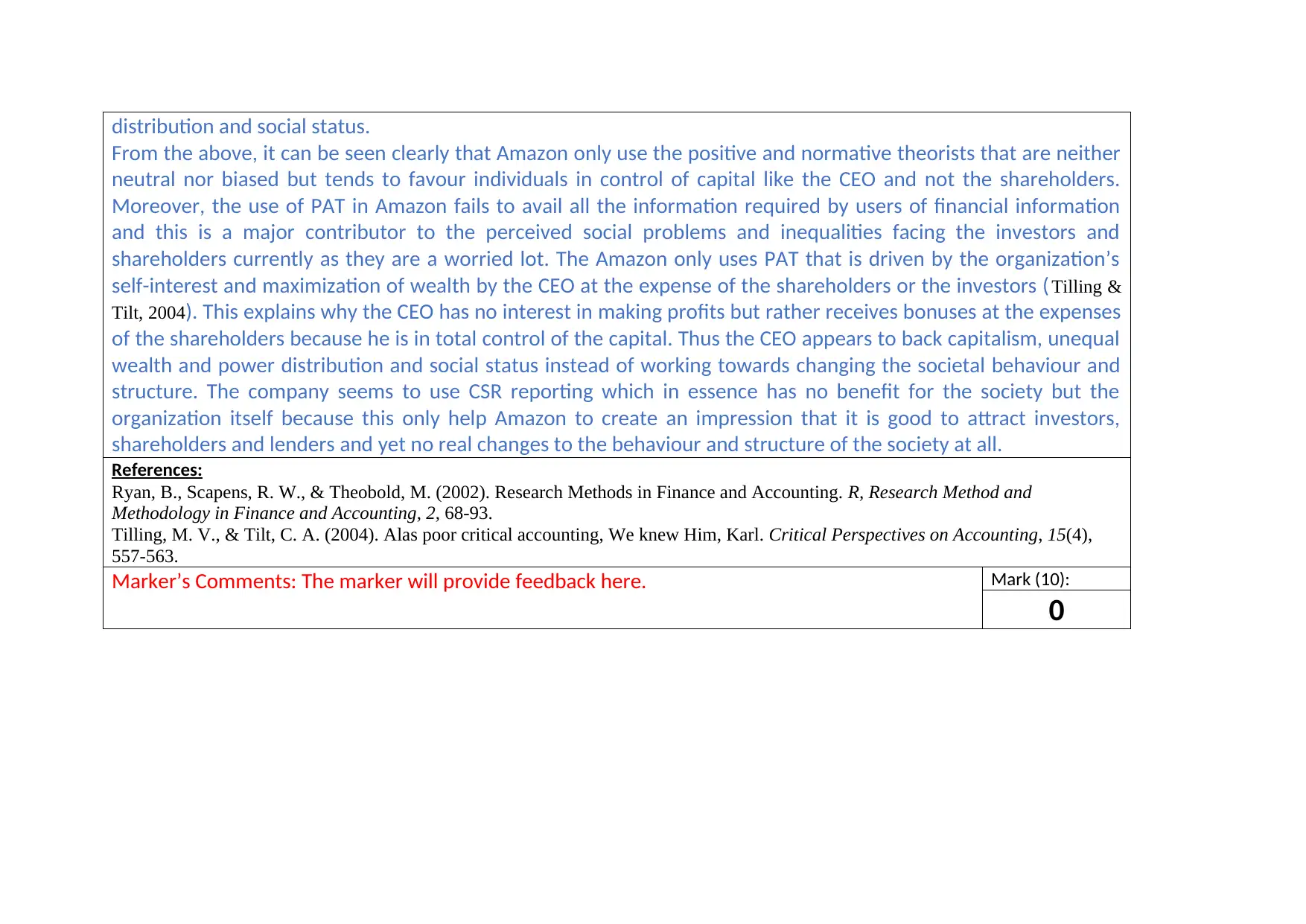
distribution and social status.
From the above, it can be seen clearly that Amazon only use the positive and normative theorists that are neither
neutral nor biased but tends to favour individuals in control of capital like the CEO and not the shareholders.
Moreover, the use of PAT in Amazon fails to avail all the information required by users of financial information
and this is a major contributor to the perceived social problems and inequalities facing the investors and
shareholders currently as they are a worried lot. The Amazon only uses PAT that is driven by the organization’s
self-interest and maximization of wealth by the CEO at the expense of the shareholders or the investors ( Tilling &
Tilt, 2004). This explains why the CEO has no interest in making profits but rather receives bonuses at the expenses
of the shareholders because he is in total control of the capital. Thus the CEO appears to back capitalism, unequal
wealth and power distribution and social status instead of working towards changing the societal behaviour and
structure. The company seems to use CSR reporting which in essence has no benefit for the society but the
organization itself because this only help Amazon to create an impression that it is good to attract investors,
shareholders and lenders and yet no real changes to the behaviour and structure of the society at all.
References:
Ryan, B., Scapens, R. W., & Theobold, M. (2002). Research Methods in Finance and Accounting. R, Research Method and
Methodology in Finance and Accounting, 2, 68-93.
Tilling, M. V., & Tilt, C. A. (2004). Alas poor critical accounting, We knew Him, Karl. Critical Perspectives on Accounting, 15(4),
557-563.
Marker’s Comments: The marker will provide feedback here. Mark (10):
0
From the above, it can be seen clearly that Amazon only use the positive and normative theorists that are neither
neutral nor biased but tends to favour individuals in control of capital like the CEO and not the shareholders.
Moreover, the use of PAT in Amazon fails to avail all the information required by users of financial information
and this is a major contributor to the perceived social problems and inequalities facing the investors and
shareholders currently as they are a worried lot. The Amazon only uses PAT that is driven by the organization’s
self-interest and maximization of wealth by the CEO at the expense of the shareholders or the investors ( Tilling &
Tilt, 2004). This explains why the CEO has no interest in making profits but rather receives bonuses at the expenses
of the shareholders because he is in total control of the capital. Thus the CEO appears to back capitalism, unequal
wealth and power distribution and social status instead of working towards changing the societal behaviour and
structure. The company seems to use CSR reporting which in essence has no benefit for the society but the
organization itself because this only help Amazon to create an impression that it is good to attract investors,
shareholders and lenders and yet no real changes to the behaviour and structure of the society at all.
References:
Ryan, B., Scapens, R. W., & Theobold, M. (2002). Research Methods in Finance and Accounting. R, Research Method and
Methodology in Finance and Accounting, 2, 68-93.
Tilling, M. V., & Tilt, C. A. (2004). Alas poor critical accounting, We knew Him, Karl. Critical Perspectives on Accounting, 15(4),
557-563.
Marker’s Comments: The marker will provide feedback here. Mark (10):
0
⊘ This is a preview!⊘
Do you want full access?
Subscribe today to unlock all pages.

Trusted by 1+ million students worldwide
1 out of 9
Related Documents
Your All-in-One AI-Powered Toolkit for Academic Success.
+13062052269
info@desklib.com
Available 24*7 on WhatsApp / Email
![[object Object]](/_next/static/media/star-bottom.7253800d.svg)
Unlock your academic potential
Copyright © 2020–2025 A2Z Services. All Rights Reserved. Developed and managed by ZUCOL.





